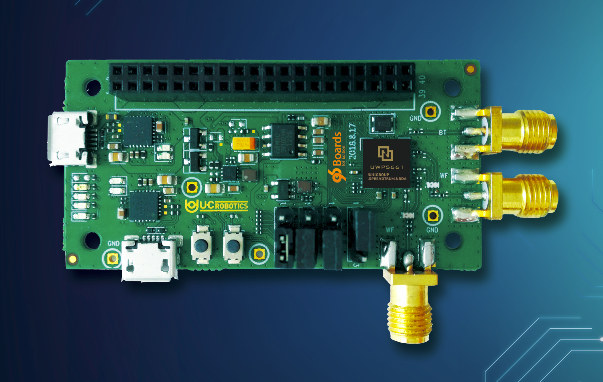If you ever wanted to start a new IoT project with WiFi and Bluetooth connectivity, you’d like think about using Espressif ESP32 WiSoC that supports single band 802.11 b/g/n WiFi (WiFi 4) and Bluetooth 4.2 LE thanks to great community and software support on top of the ultra low cost of the solution. But in case your require 802.11ac (WiFI 5) – yes, I’m trying hard to get used to the new WiFi naming scheme for consumers -, or Bluetooth 5, Espressif Systems does not offer such solution yet.
Instead you may consider UniSoC UWP5661 Arm Cortex-M4 WiSoC with WiFi 5 & Bluetooth 5 connectivity that will be found in the soon-to-be-launched UcRobotics IVY5661 96Boards IoT Edition board.
I could not find lots of information about UWP5661 chip tself, so let’s jump directly to IVY5661 board specifications:
- SoC – UniSoC UWP5661 dual core Arm Cortex-M4 microcontroller @ 416 MHz manufactured with 28nm process
- Storage – 32Mbit NOR flash
- Connectivity (built-in SoC) – Dual band 802.11ac 2×2 MIMO WiFi, Bluetooth 5
- USB – 2x Micro USB
- Expansion Interface – 96boards LS (Low Speed) connector with UART, I2C, SPI, I2S, GPIO
- Misc – 4x user LED, 2x reset and user button
- Power Supply – 5V via Micro USB port
- Dimensions – 60 x 30 mm (96Boards IoT edition form factor)
The board runs Zephyr OS (see commits), and documentation should eventually become available in the product page on 96Boards website, now mostly filled with “coming soon” since the board has yet to launch.
As a side note, UniSoC is born out of the merger between Spreadtrum and RDA Micro, and has become the third company worldwide in terms of mobile chip sales behind Qualcomm and Mediatek, as I found in Charbax’ video about IVY5661 board shot at the most recent Linaro Connect.
We still don’t know pricing and availability information, except a “good price” is expected. I’d wish for a $10 board, but most 96Boards are not known for their aggressive pricing so we’ll have to wait and see.

Jean-Luc started CNX Software in 2010 as a part-time endeavor, before quitting his job as a software engineering manager, and starting to write daily news, and reviews full time later in 2011.
Support CNX Software! Donate via cryptocurrencies, become a Patron on Patreon, or purchase goods on Amazon or Aliexpress. We also use affiliate links in articles to earn commissions if you make a purchase after clicking on those links.






Judging by pictures of some of their other boards on Twitter, I’d say the USB ports aren’t actually USB, but connects to an FTDI USB to serial interface. https://twitter.com/96Boards/status/956542267564744705
The location of the ports relative to the MCU, and the fact that they both visibly enter the QFN packages on the left does make it relatively unlikely.
Hopefully one of them is a (decent) debug interface.
There’s also a slide in the keynote that specifies the interfaces. USB is conspicuously absent.
https://youtu.be/zjbF7or2GJs?t=1044
I don’t think any really cares too much about native USB on a wireless MCU though, as it’s not going to spend much time near your computer – just long enough to get the peripherals working and a bootloader on it.
Or you wait for someone else to do that for you.
This spec list as part of their Zephyr pull request looks the most likely to be accurate:
Hardware
********
96Boards IVY5661 provides the following hardware components:
– Unisoc UWP5661 in 28nm package
– ARM |reg| 32-bit Cortex |reg|-M4 Dual Core CPU
– 416 MHz max CPU frequency
– 4MB Flash
– 640KB SRAM
– IEEE802.11ac 2×2 Wi-Fi
– Bluetooth 5
– 4 User LEDs
– Reset and User button
– GPIO with external interrupt capability
– UART (2)
– I2C (1)
– SPI (1)
– I2S (1)
Why wouldn’t USB be useful? Obviously this is a full-on, dual-core Cortex-M4, but having the USB bus as an interface on Wi-Fi SoCs is otherwise a very simple way of getting a fairly fast interface to a more powerful processor. There are even Bluetooth and ZigBee chips out there with native USB, although only 1.1, rather than 2.0 which you’d really want for a Wi-Fi chip.
The question in this case though is, how good is their software stack?
What software stack? 😛
Is USB useful? Sure. But not -that- useful.
It would be hard for something like this to compete on cost against dedicated USB or SDIO network processors if you’re wanting a a co-processor for a more powerful system.
I see a lot more of these sorts of devices end up as the network processor for dedicated real-time core or FPGA – these things don’t often have USB. I think that’s possibly why they’re targeting Zephyr first.
It’s definitely grunty enough to do things on its own though, so why not just use it as is?
Their github has a slightly better picture of the board, though it has been photoshopped a bit.
https://raw.githubusercontent.com/easonxiang/zephyr/master/boards/arm/96b_ivy5661/doc/img/96b_ivy5661.jpg